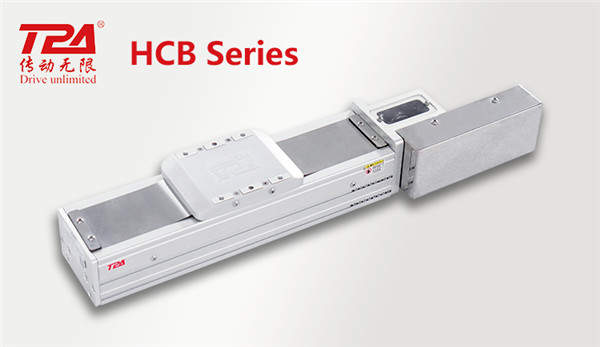1. Timing belt linear actuator definition
Timing belt linear actuator is a linear motion device composed of linear guide, Timing belt with aluminum extrusion profile connected to motor, Timing belt linear actuator can achieve high speed, smooth and accurate movement, in fact, Timing belt linear actuator technology provides a wide range of functions. Thrust, speed, acceleration, positioning accuracy and repeatability. Timing belt linear actuator with mechanical jaws and air jaws can accomplish various movements.
2. Timing belt linear actuator structure composition
Timing belt type linear actuator is mainly composed of: belt, linear guide, aluminum alloy profile, coupling, motor, photoelectric switch, etc.
The working principle of Timing belt type is: the belt is installed in the drive shaft on both sides of the linear actuator, which is used as the power input axis, and a slider is fixed on the belt for increasing the workpiece of the equipment. When there is an input, the slider is moved by driving the belt.
Usually the timing belt type linear linear actuator is designed in such a way that the tightness of the belt movement can be controlled on its side, which facilitates the commissioning of the equipment during the production process.

Timing belt type linear linear actuator can choose to increase the rigidity of the linear actuator by adding rigid guide according to the different load needs. Different specifications of linear actuator, the upper limit of load is different.
The accuracy of the Timing belt type linear actuator depends on the quality of the belt and the processing process in the combination, and the control of the power input will have an impact on its accuracy at the same time.
3. Timing belt linear actuator characteristics
Compared to the screw die set, the Timing belt linear die set is cheaper, only 1/5 to 1/4 of the price of the screw die set. this price is very attractive, especially for the companies with limited budget. Timing belt linear actuator is faster, longer stroke, can make long stroke Timing belt actuator, the longest can reach 4m-6m, if non-standard customization, the stroke can also be longer, suitable for long stroke high-speed operation, running speed can reach 2m/s or more.
Timing belt type linear actuator accuracy can meet the needs of most industries. The accuracy of Timing belt linear actuator can reach ±0.05m, also has reached the degree of high precision, used for cutting certain things, has been able to meet the requirements. The accuracy of the Timing belt actuator that has been debugged by the standard manufacturer can reach ±0.02mm.
The transmission efficiency is higher than that of the screw die set (ball screw die set efficiency 85%-90%, Timing belt die set efficiency up to 98%).
The gantry mechanism must be combined with the Y-axis linkage linkage, otherwise the slave end will appear hysteresis movement Timing phenomenon.
Timing belt actuator and screw actuator are relatively not suitable for high thrust and high precision equipment.
4. Application of Timing belt actuator
Timing belt actuator is widely used in general automation equipment can be applied, commonly used in the following equipment: dispensing machine, glue machine, automatic screw locking machine, transplanting robot, 3D angling machine, laser cutting, spraying machine, punching machine, small CNC machine tools, engraving and milling machine, sample plotter, cutting machine, transfer machine, classification machine, testing machine and applicable education and other places.
5. Explanation of parameters related to Timing belt actuator
Repeat positioning accuracy: It refers to the consistent degree of continuous results obtained by applying the same output to the same actuator and completing repeated positioning several times. Repeat positioning accuracy is influenced by the characteristics of servo system, clearance and rigidity of feed system and friction characteristics. Generally, the repeat positioning accuracy is a chance error that is normally distributed, which affects the consistency of multiple movements of the actuator and is a very important performance index.
Lead: refers to the circumference of the Timing to the active wheel in the actuator, also represents the linear distance (unit is generally mm: mm) that the load fixed on the Timing belt advances for each rotation of the active wheel driven by the motor.
Maximum speed: It refers to the maximum value of linear speed that the actuator can reach under different lead lengths.
Maximum load: The maximum weight that can be loaded by the moving part of the actuator, and different installation methods will have different forces.
Rated thrust: The rated thrust that can be achieved when the actuator is used as a thrust mechanism.
Standard stroke, interval: The advantage of modular purchase is that the selection is fast and in stock. The disadvantage is that the stroke is standardized. Although you can also order special sizes with the manufacturer, but the conventional standards are given by the manufacturer, so the standard stroke is the manufacturer's spot model, the interval is the difference between different standard strokes, generally by the maximum stroke as the maximum, down the equal difference series for example: standard stroke 100-2550m interval: 50m then the standard stroke of the spot of the model is. Is: 100/150/200/250/300/350... .2500, 2550mm.
6. The selection process of Timing belt actuator
According to the design application conditions to determine the actuator type: cylinder, screw, Timing belt, rack and pinion, linear motor actuator, etc.
Calculate and confirm the repeatable positioning accuracy of the actuator: compare the repeatable positioning accuracy of the demand and the repeatable positioning accuracy of the actuator, and select the appropriate precision actuator.
Calculate the maximum linear running speed of the actuator and determine the guide range: Calculate the running speed of the designed application, select the suitable actuator by the maximum speed of the actuator, and then determine the size of the actuator guide range.
Determine the installation method and maximum load weight: Calculate the load mass and torque according to the installation method.
Calculate the demand stroke and the standard stroke of the actuator: Match the standard stroke of the actuator according to the actual estimated stroke.
Confirm the actuator with motor type and accessories: whether the motor is brake, encoder form, motor brand.
Post time: Dec-28-2022













